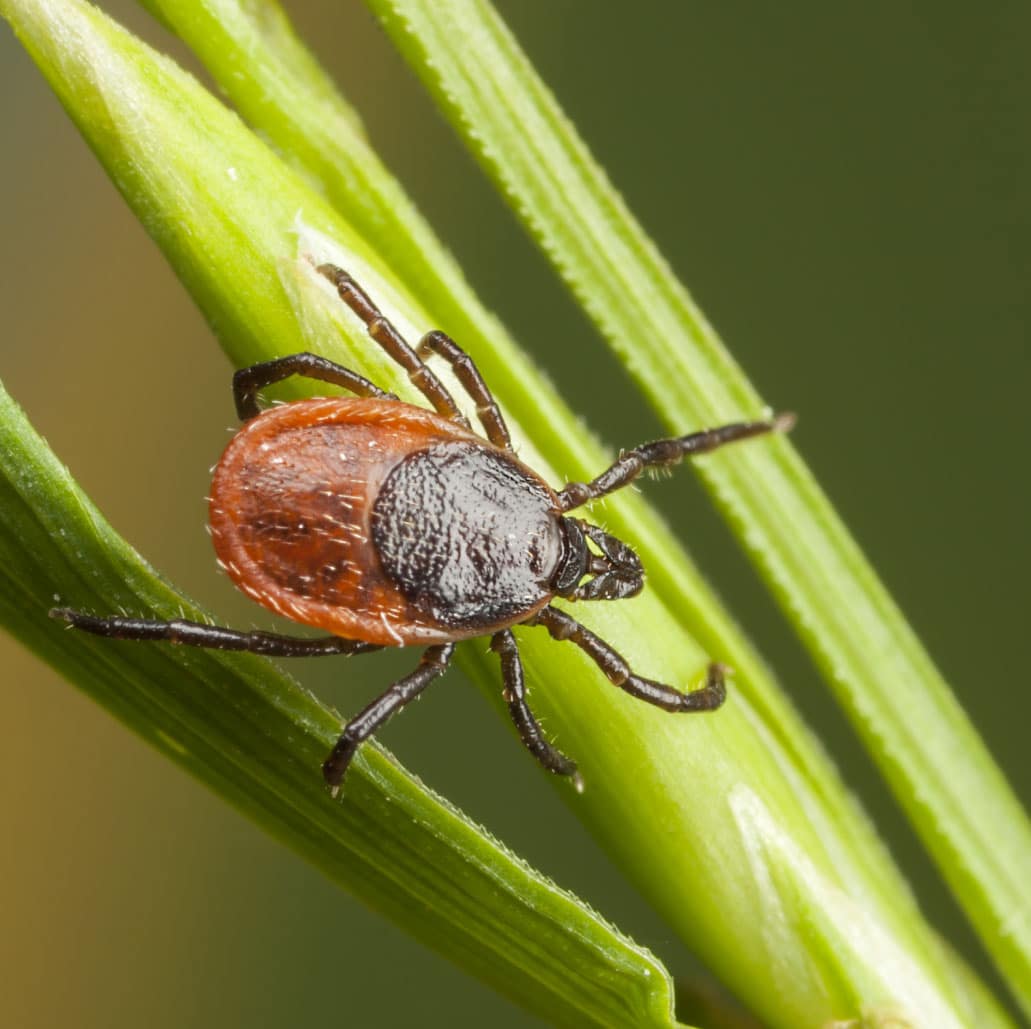
Tick Pest Control in Phoenix, Arizona

Tick Activity in Arizona
There are hundreds of types of ticks found across the world, but only 25 of them can be found in Arizona. The three most common types of ticks found in Arizona are Brown dog tick, Rocky Mountain wood tick, and Western black-legged tick.
Common Ticks in AZ
Brown Dog Tick
Brown dog ticks are the most frequently reported. They are distinguished from other species of ticks by their reddish-brown color. Their most common prey are dogs, yet they’ve grown a liking for humans over the years. Most resilient of all ticks, brown dog ticks can go through their entire life cycle indoors and survive up to two years without a blood meal.
Rocky Mountain Wood Tick
Like American dog ticks, Rocky Mountain wood ticks are bright and reddish with tear-dropped-shaped bodies and a life cycle of up to 3 years. Wood ticks are also known to carry Rocky Mountain spotted fever, tularemia, anaplasmosis, Colorado tick fever, and tick paralysis.
Western Black-Legged Tick
The Western Black-legged Tick is a prominent source of Lyme disease throughout the Western United States. Adults remain active from about December to early summertime.
Are Ticks Harmful?
Not only do ticks suck blood from their host, but they can also transmit Rocky Mountain spotted fever, tick-borne relapsing fever, or Lyme disease.
If bitten by a tick, the sooner you remove it, the better. Follow CDC guidelines for proper removal. Use tweezers and try to grab the tick as close to your skin as possible, then pull straight up. To avoid releasing fluids into the wound, try not to squeeze the tick’s body when pulling it out.
Don’t twist or jerk the tick; this can cause mouth-parts to break off and remain in the skin. If mouthparts do break off and remain in the skin, tweezers are, again, a good tool for removal. If, however, you are unable to remove these mouthparts easily, leave the wound alone, and let it heal.
After removing the tick, thoroughly clean the bite area and your hands with rubbing alcohol, and soap, and water.
How is Your Dog Picking Up Ticks?
Ticks reside in areas where there’s a lot of debris. They can be found underneath piles of leaves, long vegetation, and woodpiles. If your dog likes to play in areas with a large amount of debris, it can bring ticks back.
Dog parks are a big factor when it comes to tick bites in dogs. Visiting a dog park puts your pet at high risk of picking up ticks from other dogs. That’s why veterinarians recommend treating your dog for ticks before and after dog park visits.
Ways to Protect Your Dog From Ticks
- Keep your pets away from tall grass and areas with heavy debris.
- Avoid dog parks and other areas where there are known tick infestations.
- Utilize veterinarian-recommended tick treatment products for your pet.
- Regularly check your dog for ticks.

DIY Tick Repellant
Knowing that twenty-five species of tick reside in Arizona, it’s no wonder you’re looking to protect yourself and your family from a tick bite and all the dangers that come with it. You might already possess some common natural repellents that could be used alongside professional tick control services and extermination.
Some natural, over-the-counter concoctions for tick repellent include:
- Cedar Oil
- Eucalyptus Oil
- Neem Oil
- Apple Cider Vinegar
- Essential Oils (such as lemon, orange, lavender, peppermint, rose geranium, and cinnamon)
- Eating Garlic
A simple recipe you can try to ward off ticks includes:
Ingredients:
- 30 drops of essential oil (choose one or a combination of the following: cedarwood, eucalyptus, lavender, lemon, or lemongrass)
- 2 tablespoons of carrier oil (such as almond oil, jojoba oil, or coconut oil)
- 1 tablespoon of water
- A small spray bottle
After mixing the ingredients together and shaking the bottle, apply it directly to the skin and clothes like you would mosquito spray. Reapply every few hours, especially if you’re spending extensive time outdoors.
Frequently Asked Questions
What causes tick infestation in your yard?
Ticks are spread through the carriers they attach to – deer, small rodents, dogs, etc. Small rodents are a common cause of ticks in the yard, getting in through small openings in fencing. Along with this, bringing new plants into your yard can attract ticks. Tick control is especially recommended during warm, humid seasons due to the increase in the tick population that occurs.
What kills ticks in the yard?
One of the most effective forms of tick control in the yard is permethrin spray. You can find insecticides for pest extermination while not harming your plants and surfaces. Natural predators such as birds and chickens are another great form of protection against ticks. Using methods to attract these animals to your yard, such as birdhouses and bird feeders, can give you natural pest control.
What attracts ticks to your body?
Ticks are attracted to carbon dioxide and sweat. They’re drawn to the scent of the human body and the CO2 humans exhale. Ticks can also detect body heat, making warm-blooded animals particularly alluring.
Will ticks stay in your bed?
Ticks prefer to attach to a host and move on once they’re full. Living in your bed, sheets, pillows, and blankets allow ticks to feed on you, sometimes attaching to you for several days without your knowledge. Staying on top of regular integrated pest management eliminates the fear of tick infestations, especially where you sleep.
How long can a tick live on a human?
While it varies from species to species, tick larvae can remain attached and feed on a human host for around three days, while adult female ticks can stay attached for up to ten days. Once full, ticks will fall off on their own, leaving a small, red bump.

Pest Control and Removal Services
Our team works to protect Arizonan homes and businesses from daily nuisances to the most destructive pests, including:
Related Articles
Instant Pest Removal Now!
Receive an instant pest removal and pest control quote now!
















